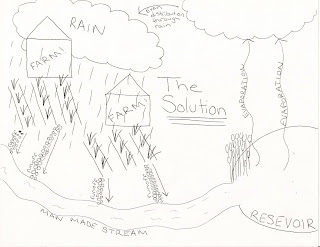Thursday, May 26, 2011
Introduction
Fertilizer run-off is apparent in many areas of the world but most specifically affects the streams and creeks in many parts of the United States, especially from Michigan to Puerto Rico. Many farmers use fertilizers on their crops and a majority of these fertilizers include nitrates. When it rains, nitrates make their way into oceans and big rivers through smaller streams and creeks. The nitrates cause major algae blooms. These blooms deplete oxygen in the ocean or rivers creating unfortunate "dead zones". The algae use large amounts of oxygen making it hard for fish and other marine life to survive. When the blooms occur and large amounts of fish die, the process releases vast amounts of carbon dioxide. The CO2 only worsens the fertilizer run-off process, making it a deadly environmental issue in our world today.
The Causes
Many different things cause fertilizer run-off. The main one is obviously fertilizer in the soil soaking into the water. Phosphorous, herbicides, and pesticides are all harmful parts of a fertilizer that pollute the water. If farmers keep producing corn crops, nitrogen pollution will greatly increase. Mississippi basin drains 48% of U.S. land nutrients combined with stratification to set up dead zones.
Our Research
Possible Causes
- Fertilizer in soil soaks into the water
- Nitrogen pollution will increase if farmers keep producing corn crops
- Mississippi basin drains 48% of U.S. land-nutrients combined with stratification set up the deadly process of creating a dead zone
- Phosphorous
- Herbicides and pesticides
Possible Solutions
- Denitrification-convert nitrate to nitrogen that’s then released into the atmosphere as a gas; not very effective in all situations
- Production of environmentally sustainable biofuel and perrenial crops
- Improved infield management of nutrients, construction, and restoration of wetlands
- Stronger nitrogen and phosphorous limits
- Use cellulosic biofuel (swtichgrass and poplar hybrids)-still being researched
- New landscape design
- No-till farming-leave more residue on top of the ground and don’t disturb the soil as much
- Plant perennials
- Rain gardens
- Use soil timing and improve timing of fertilizer applications
- More use of cover crops that hold nitrogen
- Build more wetlands to hold runoff and filter water
Works Cited:
Biello, D. (14 March 2008). Fertilizer Runoff Overwhelms Streams and Rivers-Creating Vast “Dead Zones”. Scientific American. Retrieved from http://www.scientificamerican.com/article.cfm?id=fertilizer-runoff-overwhelms-streams
DOE/Oak Ridge National Laboratory (2008, April 24). Fertilizer Run-off From Agricultural Activities Blamed For Gulf Dead Zone In Gulf Of Mexico. ScienceDaily. Retrieved May 16, 2011, from http://www.sciencedaily.com /releases/2008/04/080421143836.htm
Caruthers, E., & Everling, C., & Smoot, L. (1 January 1999). Adverse Effects of Urban Runoff. Pollution from Urban Runoff. Retrieved from http://www.cee.vt.edu/ewr/environmental/teach/gwprimer/group04/bad.htm
Gazette Editorial Board. (13 October 2010). Find more fertilizer pollution solutions. TheGazette.com. Retrieved from http://thegazette.com/2010/10/13/find-more-fertilizer-pollution-solutions/
Our Solution
Biologists and scientific agricultural experts have debated a solution to this problem for the last few years. Everything from cover crops that hold nitrogen, improved infield management, rain gardens, to denitrification has been considered. But all of these ideas are either impractical or too expensive. Alternately, there is a new and better solution to this problem. By creating a man-made river system located closely to fields and farms, the run-off water would travel down the river into a man-made reservoir. Here the harmful water would stay out of the oceans and natural rivers and lakes. If cheap enough, a water treatment system could even be put into effect to convert nitrates to nitrogen that would be released into the atmosphere as a gas. All of this combined with improved landscape designs and no till fertilizers that would leave more residues on top ground could solve the fertilizer run-off issue.
Subscribe to:
Comments (Atom)

